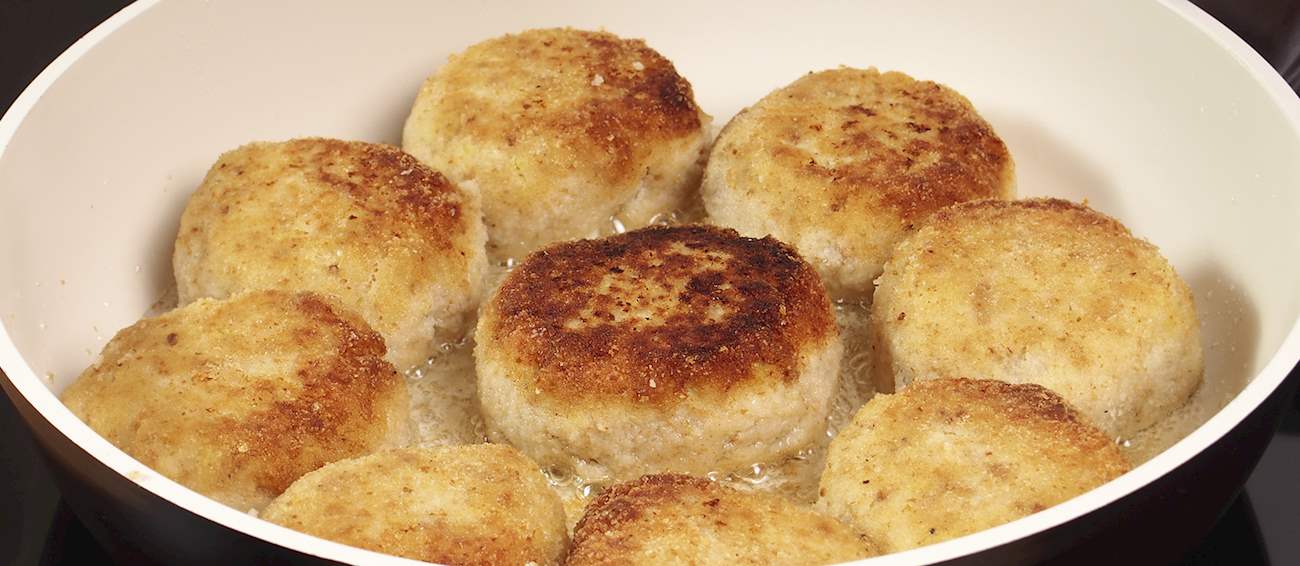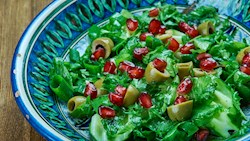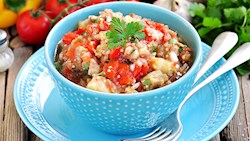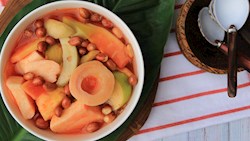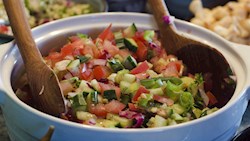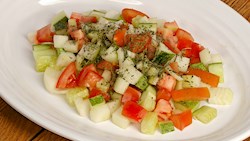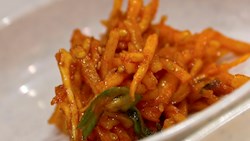Kateh is one of the easiest and simplest techniques for preparing and serving rice, preferably long-grained because it absorbs water better than most other types of rice. The rice is washed, drained, and cooked in lightly salted and oiled water.
It is cooked slowly, over low heat, allowing the rice to absorb all of the liquid. The result is not your typical fluffy rice, but a dish with a dense texture and a clean, undisguised flavor of rice. Kateh is rarely eaten on its own and is mostly served as a side dish.
Since the preparation is not complicated, it is one of the most common side dishes in Iran.
Perkedel are Indonesian fried delicacies consisting of either mashed potatoes, ground meat, ground corn, or minced fish (perkedel ikan). The name of these savory patties is derived from the Dutch word frikadel, showing the Dutch culinary influence on Indonesian territory.
Prior to frying, the main ingredient is usually combined with finely chopped scallions and pepper, then dipped in beaten eggs. Perkedel is traditionally served as an appetizer or a side dish with soto ayam soup, although it can also be consumed as a main dish, when it is usually accompanied by nasi kuning (yellow rice).
MOST ICONIC Perkedel
View moreHummus kawarma is a traditional version of hummus. In order to prepare it, freshly made hummus is topped with fried pieces of lamb. The hummus is made from chickpeas, tahini, lemon juice, crushed garlic, and cold water, while the kawarma consists of chopped lamb, white vinegar, olive oil, and spices such as pepper, allspice, cinnamon, nutmeg, oregano or za’atar, mint, and parsley.
Once prepared, hummus kawarma is often garnished with chopped parsley and toasted pine nuts.
MAIN INGREDIENTS
This internationally popular, beige-colored spread is traditionally made with mashed chickpeas, tahini sesame paste, lemon juice, and garlic. People across the world love hummus for its tangy flavor and the fact that it is filled with nutrients.
When served, it is typically dressed with a drizzle of olive oil, and is then used as a dip for vegetables or a flavorful filling for flatbreads such as pita. Even today, not much is known about its origins, although the earliest mention of hummus dates back to 13th-century Egypt.
VARIATIONS OF Hummus
MOST ICONIC Hummus
View moreMAIN INGREDIENTS
Jeon, also known as Korean pancakes, represents a number of pancake-like dishes in Korean cuisine that are often served as appetizers, side dishes, or consumed as snacks. Although jeon are typically prepared in savory versions, there are also some sweet varieties of these flavorful pancakes.
At their simplest, it is food that is first coated in flour and eggs, then pan-fried in oil. Jeon incorporates ingredients such as thinly sliced meat, poultry, seafood, and various vegetables. The pancakes are traditionally prepared every year during the Korean Lunar New Year and Korean Harvest Festival, although they are eaten daily throughout the year.
VARIATIONS OF Jeon
MOST ICONIC Jeon
View moreMAIN INGREDIENTS
The thin pancake known as dosa is one of the most famous Indian dishes. It is made with soaked rice and black gram beans, which are ground into a paste and mixed to create a thick batter, usually left to ferment overnight. The mixture is enriched with a handful of fenugreek seeds, which give dosa its distinctive golden brown color and a delicious, crispy texture.
It is then baked on a hot oiled griddle, pertaining a delicate, thin texture and round shape. Indian dosa is a staple dish in the entire country, but some believe that dosa had originated in the south Indian state of Tamil Nadu. It is an ancient dish, whose origins are traced back to the 1st century AD, when it was first mentioned in Tamil literature.
VARIATIONS OF Dosa
MOST ICONIC Dosa
View moreDal tadka or tadkewali dal is a traditional legume-based dish originating from the northern parts of India. Although there are variations, the dish is usually prepared with toor dal (split yellow pigeon peas), garlic, ginger, onions, tomatoes, garam masala, chili peppers, ghee, cumin, coriander, turmeric, red chili powder, and fenugreek leaves.
These ingredients are cooked and mixed with tadka (tempering), consisting of spices such as asafoetida, chili peppers, and garlic that are cooked in ghee. Once prepared, dal tadka is usually garnished with coriander leaves and served hot with jeera rice and roti on the side.
Indian saag paneer is a famous vegetable curry which incorporates diced paneer cheese doused in a creamy mixture of fresh leafy greens, also known under the name saag. It is typically made with mustard, fenugreek, spinach, bathua, or collard greens, mashed and incorporated with tomatoes and a rich spice blend.
In India, the saag mixture is believed to have originated in the Punjabi region, and paneer version is just one of many varieties which incorporates this fragrant curry base. It can be enjoyed as a smaller side dish or a nutritious main meal that is usually accompanied by roti or naan.
MAIN INGREDIENTS
The Afghan bolani is a stuffed, pan-fried flatbread made with unleavened dough that is typically filled with a mixture of potato mash and various other ingredients such as spinach, spring onions, pumpkin, or even green or red lentils. In Afghanistan, bolani is not only a popular street snack but it is also often prepared at home and usually served as a side dish.
It is traditionally enjoyed warm, accompanied by coriander chutney and a creamy, mint-flavored Afghan yogurt dip called chakkah.
MAIN INGREDIENTS
This traditional Indonesian dish consists of rice cooked in coconut milk that is usually seasoned with turmeric, lemongrass, and kaffir lime leaves. Even though yellow rice is the star of nasi kuning, the dish is assembled out of other Indonesian dishes and complements, such as fried chicken, potato fritters, sliced omelet, fried anchovies, shrimps, or fried tempeh.
Sambal, the traditional Indonesian chili sauce, and serundeng (spicy fried coconut flakes) are often served as condiments. Nasi kuning is always served neatly organized on the plate, and the rice should always be placed in the middle. It is traditionally associated with the island of Java, which is considered to be the place of origin of this authentic Indonesian dish.
MOST ICONIC Nasi kuning
View moreTasteAtlas food rankings are based on the ratings of the TasteAtlas audience, with a series of mechanisms that recognize real users and that ignore bot, nationalist or local patriotic ratings, and give additional value to the ratings of users that the system recognizes as knowledgeable. For the “Top 100 Asian Side Dishes” list until April 15, 2025, 9,801 ratings were recorded, of which 5,353 were recognized by the system as legitimate. TasteAtlas Rankings should not be seen as the final global conclusion about food. Their purpose is to promote excellent local foods, instill pride in traditional dishes, and arouse curiosity about dishes you haven’t tried.
